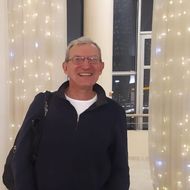Physicists from Russia and Brazil Unveil Mystery behind Complex Superconductor Patterns

The mechanism is described by the Ginzburg–Landau equation at the Bogomolny point
Scientists at HSE MIEM and MIPT have demonstrated that highly complex spatial structures, similar to the intricate patterns found in nature, can emerge in superconductors. Mathematically, these patterns are described using the Ginzburg–Landau equation at a specific combination of parameters known as the Bogomolny point. The paper has been published in the Journal of Physics: Condensed Matter.
One of the most intriguing and not fully understood questions in science is how seemingly simple natural laws give rise to complex patterns, such as zebra stripes or fish scales.
Scientists have long been trying to understand how such patterns emerge in nature. The first explanation was offered in 1952 by mathematician Alan Turing, one of the founders of computer science. According to Turing, complex patterns arise from the competition between simple interactions within a system. Thus, in chemical reactions, patterns are formed through two main mechanisms: diffusion (the distribution of substances) and autocatalysis (where the reaction accelerates itself). It soon became clear that while the Turing model can also describe the emergence of complex patterns in biology effectively, it does not account for all natural phenomena.
Scientists at HSE and MIPT, in collaboration with physicists at Universidade Federal de Pernambuco, Brazil, found that the formation of complex patterns in nature can also be explained using the Ginzburg–Landau equation that describes how the state of a superconductor changes in response to a magnetic field.
A superconductor is a material that conducts electric current without resistance, meaning there is no loss of electricity. Under the influence of a magnetic field, superconductors can exhibit different behaviours: they can either completely expel the magnetic field or allow it to penetrate their mass, forming spatial structures such as a lattice of vortices.
However, according to the theory of superconductivity, there exists a special combination of superconductor parameters—referred to as the Bogomolny point—where any structure can emerge. In this study, the scientists investigated how a magnetic field changes in response to external conditions near the Bogomolny point.

Co-author of the paper, Professor, MIEM HSE
An infinite variety of intricate configurations, like monsters, lie dormant at the Bogomolny point, waiting to be unleashed as you move away from it. Depending on how you move away from it, certain types of configurations emerge. There are various methods to move away: altering the temperature, adjusting the sample size, initiating an electric current, or stacking two superconductors atop each other. This will produce a vast array of exotic patterns.
For example, structures emerge in superconductors where regions devoid of a magnetic field coexist with regions where the magnetic field forms lattices of vortices. A superconducting film can give rise to extremely exotic patterns resembling the distribution of cases in the COVID-19 pandemic.
Co-author of the paper, Professor, MIEM HSE
Previously, superconductivity was not considered a phenomenon where complex patterns could occur, as a superconductor is a relatively simple physical system. However, it turns out that highly complex magnetic structures can indeed manifest in superconductors. Our research contributes to the current understanding of how complex patterns emerge in seemingly simple systems.
The scientists suggest that the effects observed in superconductors could be used in the development of measuring instruments. For instance, by monitoring changes in configurations within a superconductor, one can gauge the extent of temperature, current, or geometric alterations in the sample.
Vasily Stolyarov
Co-author of the paper, Director, Centre for Advanced Mesoscience and Nanotechnology, MIPT
Research in this field has been ongoing from both theoretical and experimental perspectives, as well as from a technological standpoint. Since 2018, we have been the pioneers in conducting and publishing a series of experimental studies that led to the discovery and description of the process of pattern formation on the mesoscopic scale in ferromagnetic superconductors. Now, we are actively searching for and devising new systems where superconducting patterns can be controlled, thus enabling their application in nanotechnology and nanodevices.
See also:
Using Two Cryptocurrencies Enhances Volatility Forecasting
Researchers from the HSE Faculty of Economic Sciences have found that Bitcoin price volatility can be effectively predicted using Ethereum, the second-most popular cryptocurrency. Incorporating Ethereum into a predictive model reduces the forecast error to 23%, outperforming neural networks and other complex algorithms. The article has been published in Applied Econometrics.
Administrative Staff Are Crucial to University Efficiency—But Only in Teaching-Oriented Institutions
An international team of researchers, including scholars from HSE University, has analysed how the number of non-academic staff affects a university’s performance. The study found that the outcome depends on the institution’s profile: in research universities, the share of administrative and support staff has no effect on efficiency, whereas in teaching-oriented universities, there is a positive correlation. The findings have been published in Applied Economics.
Physicists at HSE University Reveal How Vortices Behave in Two-Dimensional Turbulence
Researchers from the Landau Institute for Theoretical Physics of the Russian Academy of Sciences and the HSE University's Faculty of Physics have discovered how external forces affect the behaviour of turbulent flows. The scientists showed that even a small external torque can stabilise the system and extend the lifetime of large vortices. These findings may improve the accuracy of models of atmospheric and oceanic circulation. The paper has been published in Physics of Fluids.
Solvent Instead of Toxic Reagents: Chemists Develop Environmentally Friendly Method for Synthesising Aniline Derivatives
An international team of researchers, including chemists from HSE University and the A.N. Nesmeyanov Institute of Organoelement Compounds of the Russian Academy of Sciences (INEOS RAS), has developed a new method for synthesising aniline derivatives—compounds widely used in the production of medicines, dyes, and electronic materials. Instead of relying on toxic and expensive reagents, they proposed using tetrahydrofuran, which can be derived from renewable raw materials. The reaction was carried out in the presence of readily available cobalt salts and syngas. This approach reduces hazardous waste and simplifies the production process, making it more environmentally friendly. The study has been published in ChemSusChem.
How Colour Affects Pricing: Why Art Collectors Pay More for Blue
Economists from HSE University, St Petersburg State University, and the University of Florida have found which colours in abstract paintings increase their market value. An analysis of thousands of canvases sold at auctions revealed that buyers place a higher value on blue and favour bright, saturated palettes, while showing less appreciation for traditional colour schemes. The article has been published in Information Systems Frontiers.
New Method for Describing Graphene Simplifies Analysis of Nanomaterials
An international team, including scientists from HSE University, has proposed a new mathematical method to analyse the structure of graphene. The scientists demonstrated that the characteristics of a graphene lattice can be represented using a three-step random walk model of a particle. This approach allows the lattice to be described more quickly and without cumbersome calculations. The study has been published in Journal of Physics A: Mathematical and Theoretical.
Scientists Have Modelled Supercapacitor Operation at Molecular and Ionic Level
HSE scientists used supercomputer simulations to study the behaviour of ions and water molecules inside the nanopores of a supercapacitor. The results showed that even a very small amount of water alters the charge distribution inside the nanopores and influences the device’s energy storage capacity. This approach makes it possible to predict how supercapacitors behave under different electrolyte compositions and humidity conditions. The paper has been published in Electrochimica Acta. The study was supported by a grant from the Russian Science Foundation (RSF).
Designing an Accurate Reading Skills Test: Why Parallel Texts are Important in Dyslexia Diagnosis
Researchers from the HSE Centre for Language and Brain have developed a tool for accurately assessing reading skills in adults with reading impairments. It can be used, for instance, before and after sessions with a language therapist. The tool includes two texts that differ in content but are equal in complexity: participants were observed to read them at the same speed, make a similar number of errors, and understand the content to the same degree. Such parallel texts will enable more accurate diagnosis of dyslexia and better monitoring of the effectiveness of interventions aimed at addressing it. The paper has been published in Educational Studies.
Internal Clock: How Heart Rate and Emotions Shape Our Perception of Time
Our perception of time depends on heart rate—this is the conclusion reached by neuroscientists at HSE University. In their experiment, volunteers watched short videos designed to evoke specific emotions and estimated each video's duration, while researchers recorded their heart activity using ECG. The study found that the slower a participant's heart rate, the shorter they perceived the video to be—especially when watching unpleasant content. The study has been published in Frontiers in Psychology.
‘It Was Interesting to See How Our Chinese Colleagues Work’: HSE Researchers Take Part in Hefei Summer School
This summer, Diana Sukhoverkhova, Daria Mazur, and David Kagramanyan, research assistants at the MIEM HSE Laboratory for Computational Physics, spent five weeks in China. At the Future Scientist Exchange Program (FuSEP) summer school in Hefei, they worked in new fields of science together with their Chinese colleagues. HSE's promising scientists spoke to the HSE News Service about their intense and productive time in China.


